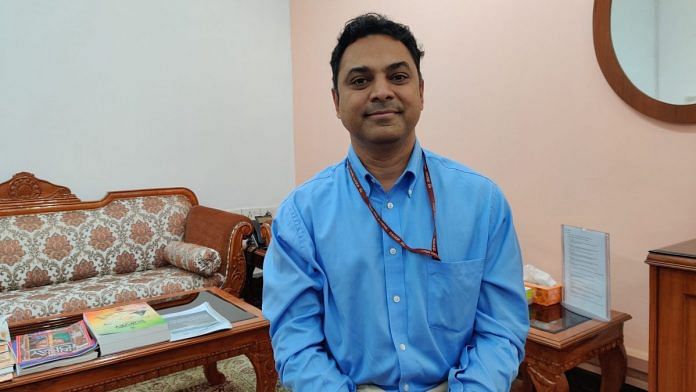New Delhi: India saw visionary leadership in three of the four economic crises that the country faced in the last three decades, with the exception being the 2008-09 global financial fallout, Chief Economic Advisor Krishnamurthy V. Subramanian said Friday.
In an interview with ThePrint, he also said that the host of reform measures being undertaken by the Narendra Modi government are as path-breaking as the historic 1991 economic reforms as they deal with the more politically-difficult market change such as labour reforms.
Subramanian said that in the 1991 economic crisis, the 1999 Asian financial crisis, and now the Covid pandemic, India has seen implementation of widespread reforms.
He, however, said that in the 2008-09 crisis, the then government put greater focus on revenue expenditure and took an “egregious decision” of debt waiver, most of which was cornered by the well-off.
“In 1991, we started respecting the invisible hand of markets. The reforms in 1991 and 1999 were mostly product market reforms. In 1999, the telecom sector was opened up and small scale reservations were removed,” he said. “But now we are undertaking factor market reforms that are harder to do in a democracy, given the political economy. The importance of visionary leadership has to be emphasised here.”
He added that Prime Minister Narendra Modi has openly acknowledged the important role played by the private sector.
Labour reforms, agricultural reforms, opening up of the defence sector, changes in cryptography, financial sector reforms such as privatisation of public sector banks and raising the FDI limit in insurance to 74 per cent are some of the important reforms undertaken by the Modi government, he said.
“I have absolutely no doubt that when history looks back at this period, history will indeed acknowledge that these reforms were as path-breaking as the 1991 reforms,” he added.
Subramanian further said that the government is placing a lot of focus on implementation of many of its announcements including privatisation and asset monetisation.
On economic recovery
The CEA said that the implementation of the reforms and the government’s push for capital expenditure will see the Indian economy grow at 6.5-7 per cent in 2022-23.
“Both the investment rate in the economy and the incremental capital output ratio will get impacted because of the reforms and the capex-driven approach,” he explained.
“Privatisation, for instance, is effectively assets being transferred from those that are not utilising it as efficiently to those that can utilise it efficiently. If you take asset monetisation, those are basically taking idle assets that are not being used productively to those who use it productively. Similarly, export-linked incentives, opening up of sectors will have an impact both on investment and on enhancing productivity.
“We expect the investment rate to come close to 40 per cent. We expect growth to be between 6.5 to 7 per cent in 2022-23 and then accelerate further as the full impact of all the government’s measures starts manifesting,” he added.
The Economic Survey presented in January this year had forecast that the Indian economy will grow at 11 per cent in the current fiscal. But the forecast for double digit growth was partly on account of a low base as the economy had contracted by more than 7 per cent in 2020-21 due to the pandemic.
Subramanian said that the government is focusing on a capital expenditure-led economic recovery and is front loading capital expenditure to support economic recovery.
“The ratio of gross fixed capital formation to GDP in the fourth quarter was the highest in the last six and a half years at 34.3 per cent. It was at a 26 quarter high,” he said.
“And what was the impact of that? You actually had the construction sector growing at fourteen-and-a-half per cent, which is very important in an economy like India because it creates a lot of jobs in the informal sector.
“Consumption grew by 2.7 per cent after having declined for three consecutive quarters,” he pointed out.
Also read: How Narasimha Rao and Manmohan Singh rescued India in 1991 and made history
On what the latest sero survey means for the economy
Subramanian pointed out that the latest sero survey results seem to indicate that India may be close to achieving herd immunity.
He, however, added a caveat: “I’m a voracious consumer of epidemiological research but I’m not a producer.”
The CEA explained that with the now-prevalent Delta Plus variant, epidemiologists are of the view that at least 80 per cent of the population should have antibodies to reach herd immunity as against the earlier 60 per cent estimated for the other variants.
“If one looks at the sero survey results, 67 per cent of the population already has antibodies,” he said. “If you add around 30 per cent of the population that has been vaccinated and remove double counting, we may be close to achieving that 80 per cent.
“We may be around 70 per cent now but at the pace the vaccinations are expected to progress in August and September, I think we will quickly be reaching the 80 per cent threshold,” he added.
Specifically, the prevalence in urban areas may be around the 80 per cent mark or higher, he added, while stressing the need for remaining cautious.
Subramanian pointed out that the economic fortunes of the entire world have been inextricably linked with the pandemic. He added that as the pace of vaccinations picks up, hospitalisation and deaths will start coming down.
This will encourage people to consume more, he pointed out.
(Edited by Arun Prashanth)
Also read: $97 mn in 1991 to $82 bn in 2021 — how reforms made India a go-to destination for FDI



